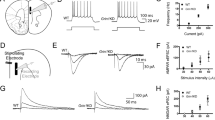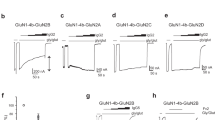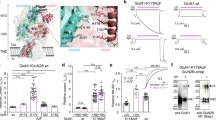Abstract
N-methyl-d-aspartate receptors (NMDARs) play important roles in brain development and neurological disease. We report two individuals with similar dominant de novo GRIN1 mutations (c.1858 G>A and c.1858 G>C; both p.G620R). Both individuals presented at birth with developmental delay and hypotonia associated with behavioral abnormalities and stereotypical movements. Recombinant NMDARs containing the mutant GluN1-G620R together with either GluN2A or GluN2B were evaluated for changes in their trafficking to the plasma membrane and their electrophysiological properties. GluN1-G620R/GluN2A complexes showed a mild reduction in trafficking, a ~2-fold decrease in glutamate and glycine potency, a strong decrease in sensitivity to Mg2+ block, and a significant reduction of current responses to a maximal effective concentration of agonists. GluN1-G620R/GluN2B complexes showed significantly reduced delivery of protein to the cell surface associated with similarly altered electrophysiology. These results indicate these individuals may have suffered neurodevelopmental deficits as a result of the decreased presence of GluN1-G620R/GluN2B complexes on the neuronal surface during embryonic brain development and reduced current responses of GluN1-G620R-containing NMDARs after birth. These cases emphasize the importance of comprehensive functional characterization of de novo mutations and illustrates how a combination of several distinct features of NMDAR expression, trafficking and function can be present and influence phenotype.
Similar content being viewed by others
Log in or create a free account to read this content
Gain free access to this article, as well as selected content from this journal and more on nature.com
or
References
Traynelis, S. F., Wollmuth, L. P., McBain, C. J., Menniti, F. S., Vance, K. M., Ogden, K. K. et al. Glutamate receptor ion channels: structure, regulation, and function. Pharmacol. Rev. 62, 405–496 (2010).
McBain, C. J., DiChiara, T. J. & Kauer, J. A. Activation of metabotropic glutamate receptors differentially affects two classes of hippocampal interneurons and potentiates excitatory synaptic transmission. J. Neurosci. 14, 4433–4445 (1994).
Paoletti, P., Ascher, P. & Neyton, J. High-affinity zinc inhibition of NMDA NR1-NR2A receptors. J. Neurosci. 17, 5711–5725 (1997).
Parsons, M. P. & Raymond, L. A. Extrasynaptic NMDA receptor involvement in central nervous system disorders. Neuron 82, 279–293 (2014).
Endele, S., Rosenberger, G., Geider, K., Popp, B., Tamer, C., Stefanova, I. et al. Mutations in GRIN2A and GRIN2B encoding regulatory subunits of NMDA receptors cause variable neurodevelopmental phenotypes. Nat. Genet. 42, 1021–1026 (2010).
Hamdan, F. F., Gauthier, J., Araki, Y., Lin, D. T., Yoshizawa, Y., Higashi, K. et al. Excess of de novo deleterious mutations in genes associated with glutamatergic systems in nonsyndromic intellectual disability. Am. J. Hum. Genet. 88, 306–316 (2011).
Carvill, G. L., Regan, B. M., Yendle, S. C., O'Roak, B. J., Lozovaya, N., Bruneau, N. et al. GRIN2A mutations cause epilepsy-aphasia spectrum disorders. Nat. Genet. 45, 1073–1076 (2013).
Kingwell, K. Epilepsy: GRIN2A mutations identified as key genetic drivers of epilepsy-aphasia spectrum disorders. Nat. Rev. Neurol. 9, 541 (2013).
Lemke, J. R., Lal, D., Reinthaler, E. M., Steiner, I., Nothnagel, M., Alber, M. et al. Mutations in GRIN2A cause idiopathic focal epilepsy with rolandic spikes. Nat. Genet. 45, 1067–1072 (2013).
Lesca, G., Rudolf, G., Bruneau, N., Lozovaya, N., Labalme, A., Boutry-Kryza, N. et al. GRIN2A mutations in acquired epileptic aphasia and related childhood focal epilepsies and encephalopathies with speech and language dysfunction. Nat. Genet. 45, 1061–1066 (2013).
Pierson, T. M., Yuan, H., Marsh, E. D., Fuentes-Fajardo, K., Adams, D. R., Markello, T. et al. GRIN2A mutation and early-onset epileptic encephalopathy: personalized therapy with memantine. Ann. Clin. Transl. Neurol. 1, 190–198 (2014).
Yuan, H., Hansen, K. B., Zhang, J., Pierson, T. M., Markello, T. C., Fajardo, K. V. et al. Functional analysis of a de novo GRIN2A missense mutation associated with early-onset epileptic encephalopathy. Nat. Commun. 5, 3251 (2014).
Burnashev, N. & Szepetowski, P. NMDA receptor subunit mutations in neurodevelopmental disorders. Curr. Opin. Pharmacol. 20, 73–82 (2015).
Yuan, H., Low, C. M., Moody, O. A., Jenkins, A. & Traynelis, S. F. Ionotropic GABA and glutamate receptor mutations and human neurologic diseases. Mol. Pharmacol. 88, 203–217 (2015).
Hu, W., Mayer, S., Yuan, H. & Traynelis, S. F. Human GRIN2B mutations in neurodevelopmental disorders. J. Pharmacol. Sci. 132, 115–121 (2016).
Lemke, J. R., Geider, K., Helbig, K. L., Heyne, H. O., Schutz, H., Hentschel, J. et al. Delineating the GRIN1 phenotypic spectrum: a distinct genetic NMDA receptor encephalopathy. Neurology 86, 2171–2178 (2016).
Li, D., Yuan, H., Ortiz-Gonzalez, X. R., Marsh, E. D., Tian, L., McCormick, E. M. et al. GRIN2D recurrent de novo mutation is an autosomal dominant cause of severe epileptic encephalopathy treatable with NMDA receptor channel blockers. Am. J. Hum. Genet. S0002-9297, 30287–30287 (2016).
Swanger, S. A., Chen, W., Wells, G., Burger, P. B., Tankovic, A., Bhattacharya, S., Strong, K. L. et al. Mechanistic insight into NMDA receptor dysregulation by disease-associated rare variants in the GluN2A and GluN2B agonist binding domains. Am. J. Hum. Genet. 99, 1261–1280 (2016).
Lesca, G., Rudolf, G., Labalme, A., Hirsch, E., Arzimanoglou, A., Genton, P. et al. Epileptic encephalopathies of the Landau-Kleffner and continuous spike and waves during slow-wave sleep types: genomic dissection makes the link with autism. Epilepsia 53, 1526–1538 (2012).
Epi, K. C., Epilepsy Phenome/Genome, P., Allen, A. S., Berkovic, S. F., Cossette, P., Delanty, N. et al. De novo mutations in epileptic encephalopathies. Nature 501, 217–221 (2013).
Ohba, C., Shiina, M., Tohyama, J., Haginoya, K., Lerman-Sagie, T., Okamoto, N. et al. GRIN1 mutations cause encephalopathy with infantile-onset epilepsy, and hyperkinetic and stereotyped movement disorders. Epilepsia 56, 841–848 (2015).
Tanaka, A. J., Cho, M. T., Millan, F., Juusola, J., Retterer, K., Joshi, C. et al. Mutations in SPATA5 are associated with microcephaly, intellectual disability, seizures, and hearing loss. Am. J. Hum. Genet. 97, 457–464 (2015).
Posey, J. E., Rosenfeld, J. A., James, R. A., Bainbridge, M., Niu, Z., Wang, X. et al. Molecular diagnostic experience of whole-exome sequencing in adult patients. Genet. Med. 18, 678–685 (2016).
Hansen, K. B., Tajima, N., Risgaard, R., Perszyk, R. E., Jorgensen, L., Vance, K. M. et al. Structural determinants of agonist efficacy at the glutamate binding site of N-methyl-D-aspartate receptors. Mol. Pharmacol. 84, 114–127 (2013).
Yuan, H., Hansen, K. B., Vance, K. M., Ogden, K. K. & Traynelis, S. F. Control of NMDA receptor function by the NR2 subunit amino-terminal domain. J. Neurosci. 29, 12045–12058 (2009).
Swanger, S. A., He, Y. A., Richter, J. D. & Bassell, G. J. Dendritic GluN2A synthesis mediates activity-induced NMDA receptor insertion. J. Neurosci. 33, 8898–8908 (2013).
Paoletti, P., Neyton, J. & Ascher, P. Glycine-independent and subunit-specific potentiation of NMDA responses by extracellular Mg2+. Neuron 15, 1109–1120 (1995).
Burnashev, N., Monyer, H., Seeburg, P. H. & Sakmann, B. Divalent ion permeability of AMPA receptor channels is dominated by the edited form of a single subunit. Neuron 8, 189–198 (1992).
Mori, H., Masaki, H., Yamakura, T. & Mishina, M. Identification by mutagenesis of a Mg(2+)-block site of the NMDA receptor channel. Nature 358, 673–675 (1992).
Sharma, G. & Stevens, C. F. Interactions between two divalent ion binding sites in N-methyl-D-aspartate receptor channels. Proc. Natl Acad. Sci. USA 93, 14170–14175 (1996).
Sharma, G. & Stevens, C. F. A mutation that alters magnesium block of N-methyl-D-aspartate receptor channels. Proc. Natl Acad. Sci. USA 93, 9259–9263 (1996).
Kato, N. & Yoshimura, H. Reduced Mg2+ block of N-methyl-D-aspartate receptor-mediated synaptic potentials in developing visual cortex. Proc. Natl Acad. Sci. USA 90, 7114–7118 (1993).
Kampa, B. M., Clements, J., Jonas, P. & Stuart, G. J. Kinetics of Mg2+ unblock of NMDA receptors: implications for spike-timing dependent synaptic plasticity. J. Physiol. 556, 337–345 (2004).
Mohn, A. R., Gainetdinov, R. R., Caron, M. G. & Koller, B. H. Mice with reduced NMDA receptor expression display behaviors related to schizophrenia. Cell 98, 427–436 (1999).
Halene, T. B., Ehrlichman, R. S., Liang, Y., Christian, E. P., Jonak, G. J., Gur, T. L. et al. Assessment of NMDA receptor NR1 subunit hypofunction in mice as a model for schizophrenia. Genes Brain Behav. 8, 661–675 (2009).
Ballard, T. M., Pauly-Evers, M., Higgins, G. A., Ouagazzal, A. M., Mutel, V., Borroni, E. et al. Severe impairment of NMDA receptor function in mice carrying targeted point mutations in the glycine binding site results in drug-resistant nonhabituating hyperactivity. J. Neurosci. 22, 6713–6723 (2002).
Furuse, T., Wada, Y., Hattori, K., Yamada, I., Kushida, T., Shibukawa, Y. et al. Phenotypic characterization of a new Grin1 mutant mouse generated by ENU mutagenesis. Eur. J. Neurosci. 31, 1281–1291 (2010).
Umemori, J., Takao, K., Koshimizu, H., Hattori, S., Furuse, T., Wakana, S. et al. ENU-mutagenesis mice with a non-synonymous mutation in Grin1 exhibit abnormal anxiety-like behaviors, impaired fear memory, and decreased acoustic startle response. BMC Res. Notes 6, 203 (2013).
Karakas, E. & Furukawa, H. Crystal structure of a heterotetrameric NMDA receptor ion channel. Science 344, 992–997 (2014).
Acknowledgements
We are grateful to Kelli Dejohn, Shantel Brown, Carmela Brito, Joanne Baez, Jing Zhang and Barrington Burnett for clinical and technical assistance, and critical analysis. We especially thank the families of our patients for the loving care for their children and cooperation with our work. During this work, WC was supported by the Xiangya-Emory Medical Schools Visiting Student Program; HY was supported by the Eunice Kennedy Shriver National Institute of Child Health & Human Development, NIH-R01HD082373, by the Emory+Children’s Pediatric Center Seed Grant Program, by the National Center for Advancing Translational Sciences of the National Institutes of Health under Award Number UL1TR000454, by NIH HHSN268201400169P; SFT was supported by NIH-NINDS R01NS036654, R24NS092989 and R01NS092989. TMP and CS were funded by the Cedars-Sinai institutional funding program and the Cedars-Sinai Diana and Steve Marienhoff Fashion Industries Guild Endowed Fellowship in Pediatric Neuromuscular Diseases. The content is solely the responsibility of the authors and does not necessarily represent the official views of the funding agencies.
Author contributions
SFT, SAS, HY and TMP designed the experiments and wrote the paper. WC, SAS, AT and HY performed the biological experiments and analyzed biological data. CS and TMP collected clinical information and data. CS, JMG, SMK, MT, MA, MM and TMP evaluated the patients, provided clinical assessments and whole-exome sequencing data. All authors discussed the results and implications and commented on the manuscript.
Author information
Authors and Affiliations
Corresponding author
Ethics declarations
Competing interests
SFT is a consultant for Janssen Pharmaceuticals, NeurOp, Inc., and Pfizer Inc, and co-founder of NeurOp Inc. The remaining authors declare no conflict of interest.
Rights and permissions
About this article
Cite this article
Chen, W., Shieh, C., Swanger, S. et al. GRIN1 mutation associated with intellectual disability alters NMDA receptor trafficking and function. J Hum Genet 62, 589–597 (2017). https://doi.org/10.1038/jhg.2017.19
Received:
Revised:
Accepted:
Published:
Issue date:
DOI: https://doi.org/10.1038/jhg.2017.19
This article is cited by
-
Developmental loss of NMDA receptors results in supernumerary forebrain neurons through delayed maturation of transit-amplifying neuroblasts
Scientific Reports (2024)
-
Alzheimer’s disease rewires gene coexpression networks coupling different brain regions
npj Systems Biology and Applications (2024)
-
Deficits in integrative NMDA receptors caused by Grin1 disruption can be rescued in adulthood
Neuropsychopharmacology (2023)
-
Complex functional phenotypes of NMDA receptor disease variants
Molecular Psychiatry (2022)
-
Shenzhi Jiannao formula ameliorates vascular dementia in vivo and in vitro by inhibition glutamate neurotoxicity via promoting clathrin-mediated endocytosis
Chinese Medicine (2021)



